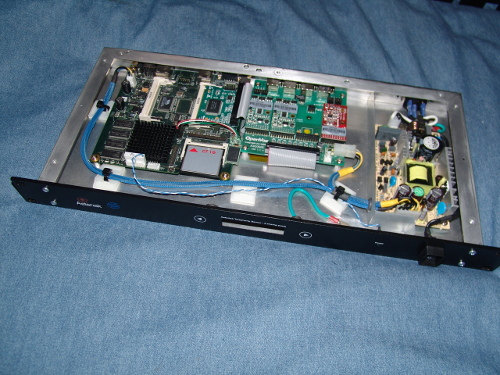
It looks like a consumer good, but this PBX server blade was built by [Benoit Frigon] over the last couple of years. It brings multiple telephone extensions to his home service.
The device runs Asterisk open source PBX software. Because it will be on all the time he wanted something that doesn’t draw a lot of power. The 500 Mhz system seen on the left has just a half a gig of ram. It’s enough to do the job and at 10 Watts it’s not going to break the bank when it comes to paying the electric bills. The board in the middle is used to interface the analog handsets with the land line. From the look of it he’s got it rigged for two extensions.
That’s all somewhat par for the course with PBX rigs, but the enclosure is where he really shines. [Benoit] used 22 gauge aluminum sheet to fabricate the enclosure which is designed to blend in with the rest of his home’s rack mount hardware. To provide control at the rack he added his own LCD and touch-sensitive button interface to the front of the case based on a PIC 18F2520. The system can also be accessed via the web thanks to a custom interface he coded.















That’s a great looking build
looks like 1/4 gig of ram, based on the article.
This looks like a great build.
My only concern is that I hope he’s using industrial grade CF cards. Consumer grade cards WILL fail in this type of use. I learned this the hard way after having several of them fail within a month of each other.
That usually has more to do with what the OS is doing to them. Read only linux distro? great! Windows install with pagefile on the CF card? nope! An improperly configured OS can easily burn a hole through just about any flash device unless it has things like write-leveling.
Yes, write cycles are the number one cause of failure, but heat is the number two.
Nice work! Can you explain the decals? Looks like you printed them in black but they ended up other colors when applied to the front panel.
Now I have to get me a nibbler! Oh honey ….
This is a great build. But calling this a blade is incorrect. It’s just a 1u rack mount PBX.
Build looks really awesome, but it’s left me with some questions…
Why build your own enclosure and not source from an old appliance off ebay that doesn’t work? I mean cool factor is obviously there, but I would have taken the lazy path.
Why not use a raspberry pi to run asterisk instead of a bring your own board solution? Again, I see the cool factor, but could have been accomplished faster.
Wrote your own web interface? Again, see the cool factor, most definitely, but man that’s a lot of work haha.
Not trying to put down your build, it really is phenomenal work and you should definitely risk breaking your arm for a well deserved back pat, but that’s the last way I would have skinned the cat. Despite what others say, the CF card is a good idea. Yes tons of cycles can fry the card, but when you think of what this thing is really doing, you’re not hitting the card much. The OS is simply routing SIP traffic, hosting a web UI with almost zero hits per day and logging (hopefully you’re not logging to disk). Unless you’re running a call center with it, that CF card will last the lifetime of device. If it doesn’t, you’re out $10.
If i had to take a guess as to why he didn’t use a raspberri pi, i’d probably say that 1. the pi wasn’t available a couple years ago when he started the build, and 2. it doesn’t look like the analog interface he’s using would be very simple to hook up to the pi.
I just realized. I wonder if there is enough juice in the telephone lines to run a pbx off of the main drop, say through a RasPi or other low power computer. Off the top of my head I believe its ~22V but I could be wrong. Throw it through a regulator? Only problem is I don’t know how much the telco would like people using large amounts of power from their lines…..
No, it is not enough. You can use parasitic power, but anything more than a couple of mA would be recognised as “off hook”.
Read the article… still don’t know what purpose this serves… anyone mind explaining?
A PBX server is a phone branch exchange, think of it as a phone router.
Since he is using a PBX with one FXO (connects to the phone company) and two FXS (connects to phones), and doesn’t mention VOIP, I assume he uses it for call monitoring more than anything.
I would however rather use a router with phone input or a server/(RasPI/equivalent) with a dial up modem, and a VOIP solution.
As he mentions using Asterisk, he could well be using a VoIP service as well, not to mention using some of the other features that Asterisk gives you (eg voicemail, extension numbers)
You are correct on closer inspection it seems like he is using both voicemail and VOIP.
I thought extension numbers were a given when you start with using PBX, at least for in house transfers.
Beautiful build. Good choice on the linux distro for the CF card. If using windows you can use ewf to reduce write cycles to the flash memory. It’ll write to RAM until you have it commit to disk.
Nice build but I wonder why anyone needs to use a PBX anymore when we have mobile phones, wifi, voip etc.
that´s the point
things line asterisk can bind all of these into one single line + your custom telco services